 |
 |
|
 |
Winter ices over northern Minnesota before moving south with biting cold |
 |
 |
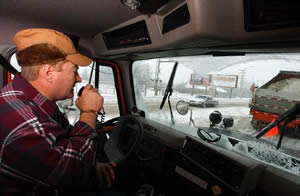 |
|
Dick Bordwell, Brainerd Truck Station, stays in touch by radio while applying de-icing chemicals on Hwy 210 in Brainerd. Photo by Steve Kohls, Brainerd Dispatch |
While the southern two-thirds of Minnesota wondered well into January where the winter went, folks up north knew all too well.
The Bemidji and Duluth districts and the northern parts of the Detroit Lakes and Brainerd/St. Cloud districts felt winter’s blunt reality early on.
During the Thanksgiving, Christmas and New Year’s weekends, Mn/DOT crews were called out to deal with the aftermath of snow, sleet and rain that froze quickly and fastened itself to everything it could, including the region’s highways.
In central and southern Minnesota, records fell, including the one documenting the absence of a snowfall greater than one inch until Jan.10.
It looked as though Mother Nature had whipped up a winter weather parfait across the map of Minnesota: layers of snow and ice on top, clear blue in the middle and a hint of whiteness on the bottom.
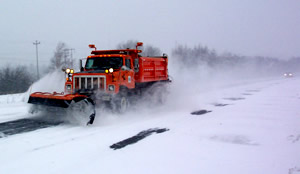 |
A snowplow driven by Doug Aho, Virginia Truck Station, clears Hwy 53 between Cotton and Virginia. Photo by Greg Pierzina |
But the parfait collapsed like a soufflé plunged in ice water as frigid Arctic air roared through the entire state on Jan. 12 and a five-inch snowfall blanketed central Minnesota. A day later, a light snowfall made winter a reality in the Twin Cities metro area and a bit more real in other regions.
As temperatures began to moderate, maintenance managers took time to assess their winter experiences through mid-January.
Dennis Redig, maintenance superintendent at Detroit Lakes, said winter began in the region in December when freezing drizzle brought five “ice events” that made clean-up efforts by Mn/DOT crews time-consuming and difficult.
December brought rain and temperatures that fell to 28 degrees below zero, he said, coating roads with as much as a half-inch of ice. Maintenance crews used a lot of salt and did a lot of blading to get many highways back into serviceable status.
“We had to scrape on it a lot,” he said.
In Crookston, Dave Dalager, District 2 maintenance superintendent, reported a similar account.
Extreme cold and ice prevented the district from obtaining bare lanes on some roads for weeks. Complicating matters, he said, was a shortage of salt in some areas.
“We could see the back walls inside a lot of our salt sheds,” he said.
The district, he said, has used about $720,000 for salt and brine so far this winter. Dalager said Bemidji generally uses about $450,000 worth of salt for an entire winter season.
“The rain followed by extreme cold is the worst scenario we can face,” he said.
 |
Doug Aho, a transportation generalist at the Virginia Truck Station, prepares to head out and plow his route on Hwy 53. Photo by Greg Pierzina |
The Duluth District recorded the state's highest snowfalls through mid-January. Mike Tardy, assistant district engineer, said the Duluth area received about 31 inches of snow as of Jan. 8, about average for the area. District 1, he said, also had to cope with several instances when freezing temperatures followed rainstorms.
Heavy use of anti-icing chemicals such as magnesium chloride and pre-wetting chemicals helped keep the district’s highways open, Tardy said.
Lee Purdham, maintenance superintendent at Brainerd, said the winter has been an unusual one so far because of the rain, extreme cold and low snowfall levels.
Purdham and other northern maintenance managers credited their crews’ dedication and perseverance dealing with the rain, extreme cold and icy conditions.
“Our people have been holding up great even though the storms occurred weekend after weekend. Their response was great and they left their families to do their jobs,” Dalager said. “You can’t ask much more than that.”
By Craig Wilkins
|
back

|
 |
Automated sprayer system helps keep Hwy 336 bridges in Moorhead free from ice |
 |
 |
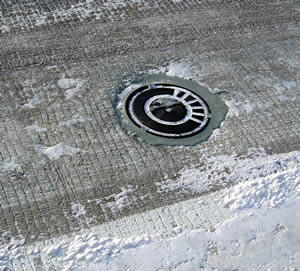 |
|
A total of 54 spray heads installed flush with the road surface help keep Hwy 336 bridges in Moorhead free from icing conditions. Photo by Shiloh Wahl |
A newly installed system that sprays three Hwy 336 bridges in Moorhead with liquid anti-icing chemicals performed well during its recent baptism by ice and sub-zero temperatures.
The system uses instruments that measure surface and air temperatures, wind speed and moisture to automatically trigger the sprayers when freezing conditions occur.
Shiloh Wahl, project manager for the bridge sprayer, said the system which includes pumps, a 2,200-gallon tank and 54 spray heads, has worked well to keep icing conditions to a minimum on the bridges over Hwy 10 and Burlington Northern Santa Fe railroad tracks.
The spraying system is one of several in use statewide by Mn/DOT to prevent icing conditions on bridges and certain sections of highways.
The Moorhead system uses potassium acetate to prevent ice from forming on the bridge decks.
“So far this winter, we’ve used a lot of chemical,” Wahl said.
By Craig Wilkins
|
back

|
 |
Mn/DOT progressing on I-394 Express lane project |
 |
 |
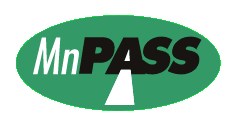 |
|
Mn/DOT's first toll lane project is expected to begin operating on I-394 in late spring 2005. |
Signs of progress are springing up along Interstate 394 on the Mn/DOT’s first express toll lane project, MnPASS I-394.
During the past several months, construction crews have been pouring footings and erecting gantries that will hold various signage and equipment for the lane. In the past few weeks, the crews have been installing signs carrying the MnPASS logo. These signs will identify the roadway, display pricing and alert drivers to the upcoming lane.
“We are making good progress,” said Ginny Crowson, Mn/DOT’s project manager. “We anticipate opening the lane sometime in late spring this year.”
The express lane project is a conversion of the I-394 high occupancy vehicle lane to a high occupancy toll lane. Currently, carpools, transit and motorcycles can use the lane for free. When the express lane begins operations, single-occupant vehicles will be allowed to access the lane by paying a toll.
Crowson added that the toll system will use dynamic pricing to control the amount of traffic in the express lane. As the number of cars using the lane increases, the tolls will rise and fewer drivers will choose to use the option. Carpools, transit and motorcycles will continue to use the lane for free.
“The lane should serve as an excellent congestion management tool,” Crowson said. “Drivers will have an option to avoid congestion by paying to use the express lane. At the same time, it will draw traffic from the general purpose lanes, which will reduce congestion there. Ultimately, we will make better use of the capacity on I-394.”
Toll collection will be entirely electronic. To access the lane, a single occupant vehicle will need an electronic tag, or transponder, that will send a signal to overhead electronic readers. The toll rate will automatically be deducted from a pre-paid transponder account. Tolls should range between $1 and $4 during the peak periods, Crowson said, although they could go higher if traffic levels warrant it.
In the next few months, Mn/DOT will open an express lane service center in Golden Valley near the intersection of Golden Valley Road and Hwy 100. Shortly thereafter, Mn/DOT will begin taking subscriptions for transponder accounts. And, when weather permits, crews will revise the lane striping on I-394 to accommodate the needs of the express lane.
For more information, visit the MnPASS Web site at www.mnpass.org.
By Kevin Gutknecht
|
back

|
 |
Northstar Project Office established |
 |
 |
On Jan 13, 2005, the Hiawatha Project Office began its transition to becoming the Northstar Project Office.
Six Mn/DOT employees will be joined by six employees from Metro Transit, six from the Northstar Corridor Development Authority, and several consultants to perform advanced and final design for the Northstar Corridor Rail Project.
The Northstar Project includes a 40-mile, six-station commuter rail line from downtown Minneapolis to Big Lake and a four-block light rail transit connection that will link the commuter rail line to Hiawatha LRT. The current capital cost estimate is $265 million in FY 2008 dollars, of which $132.5 million would be federal, $88.3 million state, and $44.2 million local funds.
This progress was made possible by funding Gov. Tim Pawlenty announced in August 2004. He arranged for the Metropolitan Council to provide $2.5 million of regional funds to match a $10 million federal grant that was about to expire.
In addition, NCDA committed $10 million from its member counties. These funds enabled the project to hire consultants for advanced and final design, continue negotiations with the Burlington Northern Santa Fe Railroad, and begin property acquisition for stations, park-and-ride lots and the maintenance facility.
The governor’s current bonding proposal includes $37.5 million for Northstar. The NCDA will also commit at least $37.5 million of its total share (this includes the $10 million commitment). Together these monies will provide the non-federal funding commitment required by the Federal Transit Administration to approve the project is entering the final design phase.
The Northstar Project Office will complete final design by December 2005 so that construction cost estimates are available for requesting the remaining state funding component from the 2006 Legislature. If all funding is made available on time, the project could open in late 2008.
Five Mn/DOT employees from the Hiawatha Project Office will continue in the Northstar Project Office: Vicki Barron, John Driscoll, Teresa Kingsley, Ernie Plutko and Jodi Thurner, all from the Metro District. They will be joined by Mike Schadauer, Office of Transit.
The Northstar Project Office will be co-located with the Hiawatha Project Office in downtown Minneapolis (Mail Stop 050, Metro District) through the close-out of the Hiawatha Project this summer.
By Mike Schadauer
|
back

|
 |
Mankato District changes management roles to reduce administrative costs |
 |
 |
The Mankato District expanded the responsibilities of three managers to reduce administrative costs and to ensure consistent service levels provided by the Mankato and Windom maintenance areas.
The actions come in response to the retirement of Gary Martinson, the former maintenance superintendent at Mankato, and the pending retirement of George Welk, assistant district engineer at Windom.
Gordon Regenscheid, assistant district engineer for operations, now manages activities in the western half of the district in addition to eastern half.
Tom Zimmerman, maintenance superintendent at Windom, now serves as maintenance superintendent for the entire district.
The new district organization will include a maintenance operations engineer to support Regenscheid and Zimmerman in areas such as bridge maintenance, building maintenance and fleet management.
The responsibilities of Greg Ous, assistant district engineer for program delivery, widen to include overseeing the construction phase for new projects.
Regenscheid and Ous will continue to have their offices in Mankato. Zimmerman will retain his office in Windom.
“As with many other state agencies, we continue to look at ways to maintain our service levels with a reduced budget,” said Jim Swanson, transportation district engineer.
“Nearly all of our staff are affected by recent staffing changes, but they are an amazingly dedicated and hard-working team and we believe we can continue to be successful with the recent changes that we made,” he said.
By Rebecca Arndt
|
back

|
 |
Electronic document management: putting information at your fingertips |
 |
 |
 |
|
Dave Pehoski, document workflow coordinator; John Aleksuk, operations specialist; Michele Bliss, records manager; Deloris Bryand, records analyst; Nancy Melvin, Document and Records Management Section director; Joy Wesaw, support technician, and Pam Newsome, document repository coordinator. Photo by David Gonzalez |
It takes many planning, design and construction documents to deliver a transportation program.
It also takes many technical, financial and administrative documents to run a state agency. These documents have to be created, filed and accessed by many people during the course of a project or task. Not having important documents available in a timely manner or useable format can result in unnecessary delays, duplication of effort and costly errors.
“Electronic document management supports the strategic direction of helping Mn/DOT work better and the transportation system operate better,” said Lt. Gov./Transportation Commissioner Carol Molnau.
“This new system also meets one of the Pawlenty-Molnau administration’s ‘Drive to Excellence’ goals to create more efficiencies in state government.”
The Electronic Document Management System consists of document management, records management and document workflow:
-
Document management involves filing electronic documents in a consistent way into a central, searchable repository.
-
Records management involves compliance with retention and other legal requirements.
-
Document workflow uses EDMS to improve work processes that involve the sharing and review of documents.
“EDMS will help Mn/DOT provide more effective transportation services,” said Dick Stehr, Engineering Services Division director and co-chair of the EDMS Advisory Team.
“Consultants, contractors and transportation partners will be able to do more business electronically. Employees will be able to access the documents they need to work efficiently.”
Mn/DOT’s Document and Records Management Section was formed in July 2003 to implement EDMS, beginning with program delivery functions in the Central Office and the districts. During those 18 months, more than 67,000 documents have been entered into the system; these documents have been accessed 662,881 times.
“That’s a good return—one document saved in EDMS and 10 customers who have been able to retrieve the document to conduct business,” said Nancy Melvin, section director.
“With EDMS, managers and employees can streamline transactions and retrieve important business documents at their desktop.”
Status of EDMS project:
-
Trunk highway plans from 1918 through 2000 are available by Web.
-
Right of way maps and utility permits are also available by Web.
-
Employees in Land Management, Materials, Technical Support and associated district functions have been trained and are using EDMS.
-
Pilot workflow projects are underway for select permit reviews and human resource vacancy filling. Based on the results of the pilots, statewide implementation will follow.
What’s next:
-
Document management training for Environmental Services, Bridge, Construction and Traffic Engineering offices and associated district functions
-
Education outreach about records management, developing the master file plan for the department, an approved records retention schedule, e-mail management policies and guidelines
-
Improved Web access to EDMS
-
Additional workflow projects
“Strategic, long-term asset and records management are vital to Mn/DOT being successful in a technologically dependent business world,” said Kevin Gray, Finance and Administration Division director and co-chair of the EDMS Advisory Team. “It will help meet the increasing demands of customers for more useable, real-time information.”
For more information about EDMS, contact Melvin, 651/297-4200, or go to the EDMS Web site at http://ihub.edms.dot.state.mn.us/html/EDMS_Main.html.
By Donna Lindberg
|
back

|
 |
Fatal crash on I-94 tests response readiness of Mn/DOT, other agencies |
 |
 |
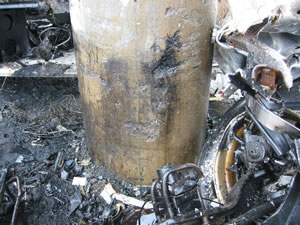 |
|
A nearly empty tanker carrying ethanol ran off I-94 in Maple Grove and crashed into a bridge pier Jan. 8. Despite the efforts of emergency medical technicians, the driver of the vehicle died at the scene. Mn/DOT determined that damage to the pier was only superficial. Photo by Dale Dombroske |
The response to a fatal truck crash Jan. 8 on Interstate 94 in Maple Grove embodied the well-rehearsed choreography of response, action, resolution and closure from the point of view of one Mn/DOT participant.
The crash occurred at 8:30 a.m. when the driver of a nearly empty tanker carrying ethanol ran off the freeway, kept on driving in the ditch and then crashed into a bridge pier where 101st Avenue crosses over the freeway.
Minutes after the crash, Dale Dombroske was paged and on the scene with State Patrol and Hennepin County officers, Maple Grove firefighters, an air ambulance crew from North Memorial Hospital, in addition to other Mn/DOT staff from the Maple Grove Truck Station and Motor Carrier Services.
Dombroske, a Metro District bridge maintenance supervisor from Maple Grove, was called to assess damage to the pier.
While waiting for access to the pier, Dombroske witnessed the smooth professionalism of the emergency response crews. While the firefighters worked to free the driver, law enforcement officers secured the accident scene.
Mike Ritchie, Hazardous Materials Section, controlled the small amount of fuel that leaked from the truck while the Maple Grove crew cleared debris, barricaded both the east- and west-bound lanes and helped route traffic off the freeway onto a detour.
Emergency medical technicians went to the aid of the driver as soon as they could reach him, but he died before he could be flown to the hospital.
John Hanzelik, maintenance supervisor at Maple Grove, said the on-duty employee was there within a few minutes; he and station workers arrived promptly as well.
Dombroske determined the pier damage was only superficial. The maintenance crew helped in many ways, including removal of the damaged tractor and trailer. They stayed at the scene until early afternoon when the freeway was re-opened.
“It was an excellent and well-organized response, especially during a weekend,” he said.
“The EMTs really worked on the guy,” he said, “but it just wasn’t within their power to save him.”
Hanzelik said the situation could have been much worse had the tanker been loaded with the highly flammable ethanol.
“An explosion or fire could have injured other motorists as well as severely damaged the highway and the bridge,” he said.
By Craig Wilkins
|
back

|
 |
|
 |



